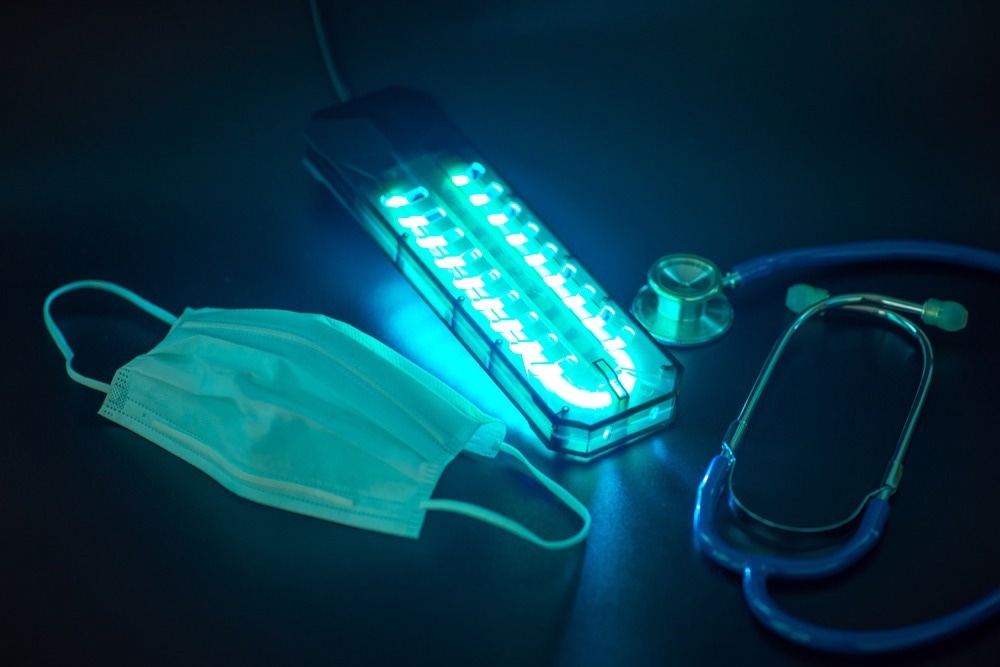In a recent study published in Scientific Reports, researchers used culture and molecular assays to provide the first dose-response for SARS-CoV-2 solution exposed to ultraviolet (UV)222.
 Study: UV222 disinfection of SARS-CoV-2 in solution. Image Credit: Nor Gal/Shutterstock
Study: UV222 disinfection of SARS-CoV-2 in solution. Image Credit: Nor Gal/Shutterstock
Background
The unprecedented increase in SARS-CoV-2 infection-induced morbidity and mortality across the globe warrants the development of approaches to curtail SARS-CoV-2 transmission. Studies have reported that inactivation of CoVs [including SARS-CoV and HCoV-OC43 (human CoV OC43)] by UV radiations but conventionally used UV lamps are hazardous to human health due to their mercury content and emitted wavelengths (254 nm). Therefore, krypton chlorine (KrCl) excimer lamps (excilamps) that emit UV radiation at 222 nm wavelength (UV222) may be preferable for CoV inactivation.
About the study
In the present study, researchers explored the feasibility of UV222 to minimize SARS-CoV-2 transmission by evaluating the dose-response kinetics of SARS-CoV-2 in an aqueous solution post-UV222 exposure emitted by KrCl excilamps.
Modified plaque assays were used to determine plaque-forming units (PFU)/mL of samples pre- and post-UV treatment and SARS‑CoV‑2 outgrowth assays were performed. Quantitative reverse transcription-polymerase chain reaction (RT-qPCR) assays targeting the SARS-CoV-2 nucleocapsid (N) gene were performed to obtain SARS-CoV-2 N gene copies/µL in viral ribonucleic acid (RNA) and assess the contribution of SARS-CoV-2 N gene damage to disinfection kinetics.
The in vitro transcribed (ITV) RNA was converted to complementary deoxyribonucleic acid (cDNA) relating N gene copy numbers to cycle threshold (CT) values. Enzyme-linked immunosorbent assays (ELISA) targeting SARS-CoV-2 N were performed to obtain SARS-CoV-2 N protein concentrations and evaluate the contribution of SARS-CoV-2 N protein damage to disinfection kinetics.
SARS-CoV-2, Isolate USA-WA1/2020 isolate, and Vero cells were used for cell culture experiments. The emission spectrum of the UV222 source was measured using a spectroradiometer, and total incident UV-C irradiance was measured using a radiometer with solar blind detectors and wide eye diffusers. The UV–vis absorbance of SARS-CoV-2 working stocks was measured using a spectrophotometer.
Results and discussion
Culture experiments (infectivity of plaques to Vero cells) showed >99.9% SARS-CoV-2 disinfection SARS-CoV-2 post-UV222 exposure at eight mJ/cm2 dosage (the pseudo-first-order rate constant was 0.6 cm2 /mJ). On day zero (i.e., immediately post-treatment with UV222), RT-qPCR analyses demonstrated a contribution of only 10% by N gene injury to the kinetics of SARS-CoV-2 disinfection, and ELISA assays showed no N protein injury contributed to the kinetics of SARS-CoV-2 disinfection.
After three days of Vero cell incubation, ELISA and RT-qPCR kinetics of the UV222 exposed virus were identical to cell culture kinetics, indicative of the validity of molecular-based assays for assessing UV-based SARS-CoV-2 disinfection without cell culture experiments. Viral infectivity UV222 dose response was characterized by exponential decay kinetics. At an average initial SARS-CoV-2 titer of 6.5× 104 PFU/mL, the pseudo-first-order rate constant for SARS-CoV-2 disinfection was − 1.5 cm2 /mJ. Post-treatment with UV222 at 1.6 mJ/cm2 dose, 90% SARS-CoV-2 inactivation was observed.
In the first test experiment, Vero cells appeared almost dead among untreated samples, and their health improved increasingly with UV222 doses of 0.7 and 1.4 mJ/cm2, and the cells were healthy at UV222 doses >2 mJ/cm2. In the second test experiment, the average initial SARS-CoV-2 titers of 3.5 × 104 PFU/mL decreased to below detectable levels (log10 reduction (LR) of ≥4.3 logs) by UV222 at 10 mJ/cm2 dose.
Compared to the LR rate constant of SARS-CoV-2 infectivity measured by plaque assays, the LR rate constant of N gene damage measured by N1 qPCR was lower by 10-fold. The lack of a robust association between the N gene damage kinetics (measured by qPCR) and SARS-CoV-2 disinfection indicates that SARS-CoV-2 N protein damage may have a higher contribution to SARS-CoV-2 disinfection compared to SARS-CoV-2 N gene damage.
However, no strong associations were observed between N protein damage kinetics and SARS-CoV-2 disinfection, which may be since only SARS-CoV-2 N protein-based analyses were performed. Therefore, damage to other proteins, such as the SARS-CoV-2 spike (S) protein, may have been missed. SARS-CoV-2 S proteins are situated on the viral surface to absorb UV radiations and therefore seem essential for host cell infection.
Conclusions
Overall, the study findings showed that Kr-Cl excilamp-emitted UV222 exposure could attenuate the integrity and infectivity of SARS-CoV-2 in an aqueous solution in a dose-dependent manner. However, the N gene and N protein may not be primary targets contributing to SARS-CoV-2 disinfection-inducing molecular-level damage. Further research is warranted to resolve the mechanical complexities of UV222-induced SARS-CoV-2 inactivation.
UV radiation could be highly beneficial in reducing SARS-CoV-2 transmission in indoor spaces such as facility centers for congregate care, homes of convalescent patients, hospital waiting rooms, and flight cabins with a high potential for SARS-CoV-2 transmission. UV radiations could be used as an adjunct to prophylactic measures such as vaccinations, face mask use, and social distancing to expand the realm of SARS-CoV-2 prevention.